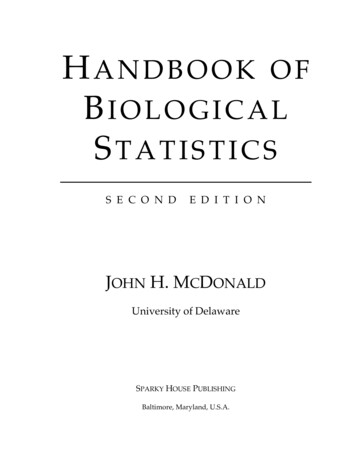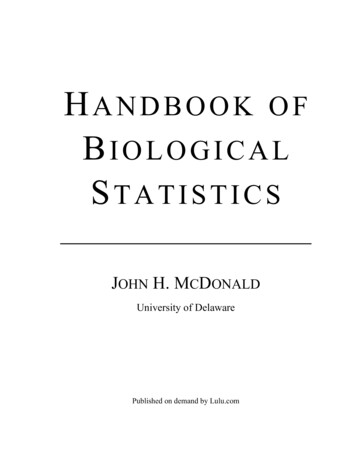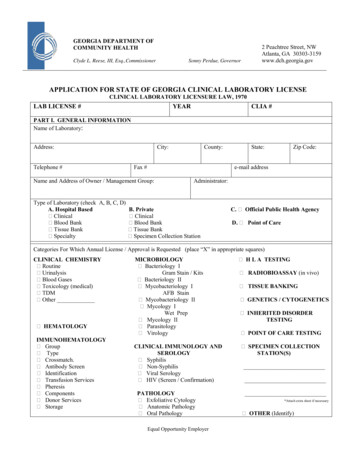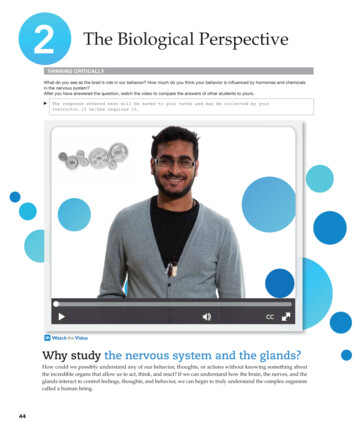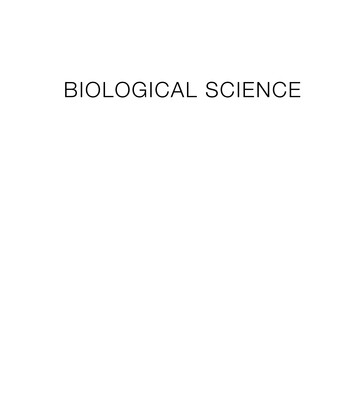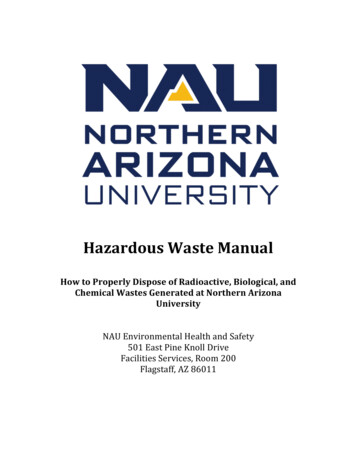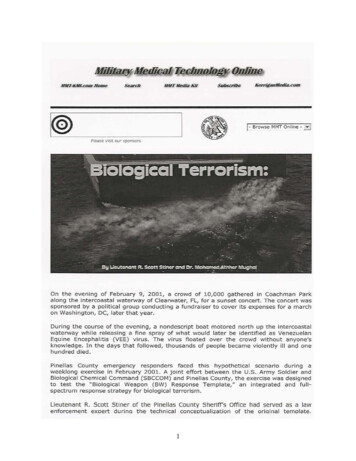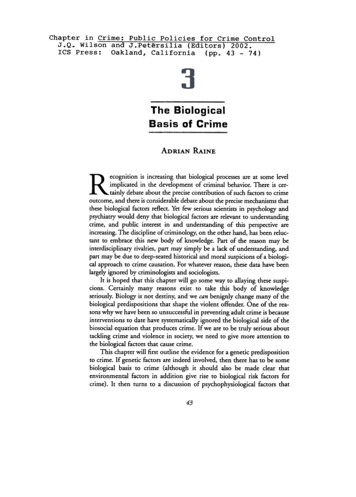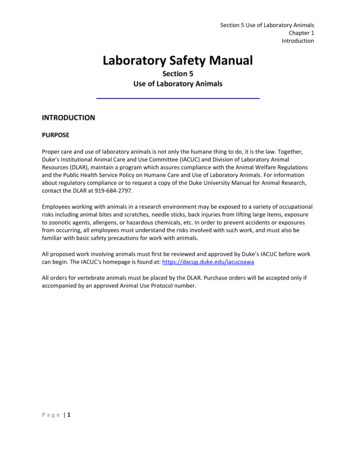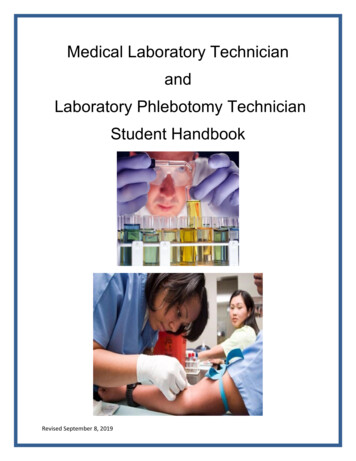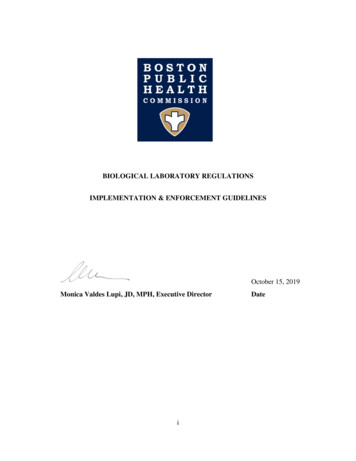
Transcription
BIOLOGICAL LABORATORY REGULATIONSIMPLEMENTATION & ENFORCEMENT GUIDELINESOctober 15, 2019Monica Valdes Lupi, JD, MPH, Executive DirectoriDate
1. AUTHORITYThe Executive Director of the Boston Public Health Commission (BPHC) has issued theseGuidelines, as authorized by Section 6.00 of the BPHC’s Biological Laboratory Regulations.2. DEFINITIONSAll terms used in these Guidelines shall have the same meaning as defined in Section 1.00 of theBPHC’s Biological Laboratory Regulations. Any other terms not defined in this document shallhave the same meaning as is used.a.“Decommission” shall mean to take a laboratory facility off-line, out of use, or changeits use. The process involves securing biological materials, decontaminating equipment(e.g., biosafety cabinets, autoclaves, centrifuges) and laboratory space; taking mechanicalsystems (e.g., ductwork, HVAC, HEPA filters, effluent decontamination systems) offline before closing out or renovating an existing laboratory.b. “Incident” shall mean an event that causes or has the potential of causing injury, illness,disease, or property damage. Incidents may include spills and accidents in biologicallaboratories which result in potential or overt exposures to recombinant DNA materials,high-risk agents or select agents or toxins; release of infectious materials or recombinantDNA materials, power failure, fire, explosion, flood, or other natural disasters liketornados, earthquakes, or hurricanes.c. “Major mechanical system” shall mean any mechanical system found in the laboratorythat is needed to safely operate the laboratory and maintain biocontainment andbiosecurity systems. It includes the physical building structure (e.g., windows, doors,walls, floors, ceilings, roof, partitions); site utility piping and plumbing; electrical system;heating, ventilation, and air conditioning (HVAC) and air handling units (AHU); HEPAfiltration units; building automation system; fire protection and suppression systems;physical and electronic security barriers (e.g., doors, locks, anterooms, interlocks, CCTV,biometric or card readers, etc.); effluent decontamination system (EDS); chemicalshowers; and pass-through autoclaves.d. “Regulated Laboratory Space” shall mean the total floor area (in square feet) of thepermitted biological laboratory at a single biosafety level, including animal rooms, wastestorage rooms, and other rooms directly serving the laboratory as determined by theBPHC.e. “Visitor” shall mean an individual, escorted or unescorted, who does not have authorizedaccess to the biological laboratory facility.1
3. PERMIT REQUIREMENTS(Refer to Section 2.00 of the Biological Laboratory Regulations).3.1Biological Laboratory Permits3.1.1 BSL-2/ABSL-2 (Recombinant DNA) PermitAny Entity operating or proposing to operate a biological laboratory using recombinantDNA (rDNA) at biosafety level 2 (BSL-2) or animal biosafety level 2 (ABSL-2) shallfirst obtain a permit for the Regulated Laboratory Space from the BPHC before any suchintended use.3.1.2 BSL-3/ABSL-3 (Non-Select Agent) PermitAny Entity operating or proposing to operate a biological laboratory or laboratories(including for rDNA use) at biosafety level 3 (BSL-3) or animal biosafety level 3 (ABSL3) shall first obtain a permit for the Regulated Laboratory Space from the BPHC beforeany such intended use.3.1.3 BSL-3/ABSL-3 (Select Agent) PermitAny Entity that intends to have, use, or transfer any select agent or toxin including receiptof select agents or toxins from outside the United States, for use (including rDNA use) atBSL-3/ABSL-3 shall first obtain a permit for the Regulated Laboratory Space from theBPHC before any such intended use.3.1.4 BSL-4/ABSL-4 PermitAny Entity operating or proposing to operate a biological laboratory or laboratories(including rDNA use) at biosafety level 4 (BSL-4) or animal biosafety level 4 (ABSL-4)shall first obtain a permit for the Regulated Laboratory Space from the BPHC before anysuch intended use.3.2Scope of Biological Laboratory Permita) Entity as Tenant or Sharing Laboratory Space: Any Entity operating or proposing tooperate a laboratory or animal facility requiring a permit (Sections 3.1.1 to 3.1.4) in aleased or shared laboratory space or using the space under any other written or verbalagreement must apply for the required permit, even if the property owner alreadyholds such a permit.2
b) The Entity may aggregate its BSL-2/ABSL-2 (rDNA) Regulated Laboratory Space(Section 3.1.1) across multiple buildings and physical addresses to apply for a singlepermit.c) The Entity may aggregate its BSL-3/ABSL-3 or BSL-4/ABSL-4 RegulatedLaboratory Space (Sections 3.12 to 3.14) located within a single building into a singlepermit of the appropriate type.d) The Entity shall not aggregate its BSL-3/ABSL-3 or BSL-4/ABSL-4 laboratories(Sections 3.12 to 3.14) that are found in different buildings and at different physicaladdresses. A separate permit is required for each building.e) The Entity shall not aggregate laboratories of different biosafety levels or types(Sections 3.1.1 to 3.1.4) into a single permit, even if they are in the same building. Aseparate permit is required for each biosafety level or type.3.3Permit Duration and Annual Renewal Datesa) All Biological Laboratory Permits are valid for one (1) year from March 1 toFebruary 28 of the following calendar year.b) The BPHC may issue a permit to any Entity that submits a new permit applicationafter March 1. The permit shall be valid from the date of issue through the end ofFebruary of the following year.c) The Entity must submit an application for annual permit renewal by January 31 eachyear.4. NEW PERMIT APPLICATION: REQUIRED DOCUMENTS(Refer to Section 2.01b of the Biological Laboratory Regulations)The Entity shall send permit application documents to the Director of Biological Safety,Environmental Health Office, Boston Public Health Commission, 1010 Massachusetts Avenue,2nd Floor, Boston, MA 02118. Contact the Environmental Health Office at 617-534-5965 orbiosafety@bphc.org if you have any questions of permit application.4.1New BSL-2/ABSL-2 (Recombinant DNA) PermitAny Entity seeking a permit to use rDNA at BSL-2/ABSL-2 must send the followingdocuments to the BPHC:3
a) Completed and signed Recombinant DNA Permit Application Form. The form isavailable on the BPHC Biosafety Program website at www.bphc.org/biosafety.b) Check for permit application fees, made payable to the Boston Public HealthCommission.c) List of all physical locations (Street address, Building, Room Number), includinganimal care and core research facilities, where rDNA materials are used or stored.d) List of all current research protocols using rDNA, including the assigned biosafetylevels and the category of non-exempt experiments (Section III of the NIHGuidelines). The BPHC may ask the Entity to provide copies of any researchprotocols.e) Description of large-scale rDNA activities, containment facilities, and equipment(Appendix K of the NIH Guidelines), if applicable.f) Biosafety Manual describing the institutional policies and procedures based on riskassessment. The Biosafety Manual must establish minimum standards and guidelinesfor the research activities and facility operations in BSL-2/ABSL-2 laboratories. Thebiosafety policies and procedures must protect laboratory personnel, public, and theenvironment from biohazardous materials, and ensure compliance with federal, state,and local regulations.g) OSHA Bloodborne Pathogens Standard Exposure Control Plan (29 CFR 1910.1030)and Chemical Hygiene Plan (29 CFR 1910.1450).h) Biological Waste Management Plan for disposal of infectious waste generated at thelaboratory facility, in compliance with 105 CMR 480.000 (Minimum Requirementsfor the Management of Medical or Biological Waste; State Sanitary Code ChapterVIII) and other applicable federal, state, and local regulations.i) A brief description of the institution’s Occupational Health Services Programapproved by the Institutional Biosafety Committee (IBC) for all persons working withrDNA materials at the laboratory facility.j) Laboratory Safety Training Program for all employees, students and visitors workingwith recombinant DNA and biohazardous materials at the laboratory facility. Thetraining modules must include information specific to recombinant DNA technologyuse and BPHC incident reporting requirements.k) Emergency Response Plan covering accidental spills, personnel contamination, orenvironmental release resulting from recombinant DNA materials.l) Brief description of the insect/rodent control program used at the facility.4
m) List of all IBC members (name and title), clearly showing the Chair, contact person,Biosafety Officer (if applicable), recombinant DNA expert, community members, andad hoc consultant (if applicable).n) Biographical sketches of all IBC members, including community members.o) Copy of IBC minutes (if the IBC has already held its first meeting).p) Copy of Laboratory Registration Permit (Boston Fire Department).q) Copy of Certificate of Occupancy (Boston Inspectional Services Department).4.2New BSL-3/ABSL-3 (Non-Select Agent) PermitAny Entity seeking a permit to operate a BSL-3/ABSL-3 facility the must send the followingdocuments to the BPHC:a) A completed and signed BSL-3/ABSL-3 Permit Application Form. The form is availableon the BPHC Biosafety Program website at www.bphc.org/biosafety.b) Check for permit application fees, made payable to the Boston Public HealthCommission.c) List of all physical locations (Street address, Building, Room Number), including animalcare and core research facilities, where rDNA materials or Risk Group 3 agents are usedor stored.d) List of all current research protocols using rDNA materials approved by the Entity’s IBC,and all Risk Group 3 agents used or stored in the Regulated Laboratory Space (Section IIIof the NIH Guidelines). The BPHC may ask the Entity to provide copies of any researchprotocols.e) Biosafety Program Management Leadership: The Entity must develop a written policysigned by senior management outlining the Entity’s commitment to provide theleadership, vision, and resources needed to implement an effective biosafety program.The senior management must show commitment to continuous improvement of thebiosafety program, communicate that commitment to all employees, set biosafetyprogram expectations, and designate roles and responsibilities.f) Biosafety/Biocontainment Plan: The Entity must develop and implement a writtenbiosafety/biocontainment plan, based on the BMBL (5th edition), NIH Guidelines, andother reputable national and international biosafety guidelines. The Plan must outline thehazardous characteristics of each high-risk agent or select agent or toxin listed on theEntity's permit application. The Plan must describe the safety measures implemented toprotect laboratory personnel, the public, and the environment from exposure to high-riskagents, select agents or toxins, or recombinant DNA materials. The safety measures may5
include elimination (physically remove the hazard), substitution (replace the hazard),engineering controls (isolate people from the hazard), administrative controls (change theway people work), and personal protective equipment (PPE) (protect the worker).g) Biosafety Manual describing the institutional biosafety policies, programs, andprocedures based on an overarching risk assessment. The Biosafety Manual mustestablish acceptable standards and guidelines for the research activities and operations inthe BSL-3/ABSL-3 or BSL-4/ABSL-4 facility. The biosafety policies and proceduresmust protect laboratory personnel, public, and the environment from biohazardousmaterials, and ensure compliance with federal, state, and local regulations. The BiosafetyManual may include a description of the biosafety program itself, and each of the coreelements described below.h) Security Plan describing the security measures implemented to prevent unauthorizedaccess, theft, loss, misuse, diversion, or intentional release of high-risk agents and selectagents or toxins from the laboratory facility. The security measures must be based onsite-specific security risk assessment of the facility, high-risk agents, and select agents ortoxins used or stored in the BSL-3/ABSL-3 or BSL-4/ABSL-4 laboratory. The SecurityPlan must include mitigation strategies for the risks associated with physical security;personnel suitability and reliability; accountability for high-risk agents, select agents ortoxins, and other regulated infectious material; inventory management; incident andemergency response; and information management.i) Hazard Evaluation or Risk Management Plan including a comprehensive review of thebiological, chemical, radiologic, or physical hazards existing in the research laboratorythat could cause harm to laboratory personnel, the public, or the environment. The Entitymust review the facility design and operational procedures, determine if hazard controlmeasures are adequate, and develop risk management plan to mitigate the identifiedhazards.j) Laboratory Safety Training Program based on a training needs assessment. The trainingprogram must include laboratory-specific or agent-specific training for researchers,laboratory personnel, and visitors who may work in the BSL-3/ABSL-3 or BSL-4/ABSL4 facility. The training program must include training for emergency responders andother city agencies, as needed. The Entity must review and update the training program,as needed.k) Emergency Response Plan/Incident Response Plan outlining the actions to be taken in theevent of a natural or man-made disaster such as biological spill, personnel exposure,release of high-risk agents, select agents or toxins, recombinant DNA materials; escape ofinfected animals; personnel injury or illness; security breaches; severe weather and othernatural disasters (e.g., flood, earthquake, or hurricane); workplace violence; bomb threatsand suspicious packages; emergencies like fire, gas leak, explosion, or power outage; or6
any other natural or man-made events that may threaten the Entity. The site-specific planmust protect public health and safety, property, and the environment. The Entity mustconsider the impact to the laboratory, the facility and surrounding community.l) Disease Surveillance and Reporting Plan implemented to prevent and detect personnelillness or disease related to occupational exposure to infectious materials.m) Biological Waste Management Plan outlining the processes and procedures implementedto ensure proper removal, treatment, and disposal of biohazardous wastes from the BSL3/ABSL-3 or BSL-4/ABSL-4, in compliance with 105 CMR 480.000 (MinimumRequirements for the Management of Medical or Biological Waste; State Sanitary CodeChapter VIII) and other applicable federal, state, and local regulations.n) Decontamination Plan describing the validated standard operating procedures fordisinfection, inactivation, or sterilization of contaminated biological materials such ascultures of high-risk agents or select agents or toxins, personal protective equipment,animal caging systems and bedding, animal carcasses, tissues or body fluids, laboratorysurfaces and equipment, and biological waste.o) Laboratory Facility Commissioning Plan describing the commissioning procedure of theBSL-3/ABSL-3 or BSL-4/ABSL-4 facility to ensure that the buildings design is properlyconstructed, compliant, and assessed so that it can be used and maintained. The Entitymust hire an independent commissioning agency to offer consulting and engineeringservices and onsite performance testing and observations to verify that mechanicalsystems meet the design intent.p) Laboratory Facility Decommissioning Plan describing decommissioning procedures ofthe BSL-3/ABSL-3 or BSL-4/ABSL-4 facility to ensure the building has been properlydecontaminated and made safe for future use. Before decommissioning, the facility mustbe decontaminated and verified according to the institution’s standard operatingprocedures.q) Transportation of Biological Materials Plan outlining the policies and procedures to befollowed when transporting Risk Groups 3 or 4 agents and select agents and toxins toensure compliance with U.S. Department of Transportation’s Hazardous MaterialsRegulations (49 CFR Parts 171-177); Federal Select Agent regulations (7 CFR Part 331,9 CFR Part 121, and 42 CFR Part 73); International Air Transport Association (IATA)Dangerous Goods Regulations (DGR); and the World Health Organization guidelines(Guidance on Regulations for the Transport of Infectious Substances 2013–2014).r)Attenuated Strain Verification Procedures for identifying attenuated organisms derivedfrom known, virulent organisms that originally required BSL-3/ABSL-3 or BSL4/ABSL-4 biocontainment when the attenuation results in a decreased virulence of theorganism, or a reduction of required biocontainment level for possession or use. The7
verification must include direct testing for the presence or absence of the virulencefactors lost in attenuation by phenotypic or genetic means. The Entity must ensure it is incompliance with the Federal Select Agent Program requirements for excepted organisms.s) Plan for Termination of Work with Biological Agents outlining the procedures for endingresearch work with high-risk agents or select agents and toxins. The plan must addressapplicable federal regulatory requirements and standards, such as the Federal SelectAgent Program regulations (7 C.F.R. Part 331, 9 C.F.R. Part 121, and 42 C.F.R. Part 73);BMBL (5th Edition or successor); Massachusetts Department of Public Health regulation(105 CMR 480.000); and BPHC’s Biological Laboratory Regulations.t) Brief description of the insect/rodent control program implemented at the facility.4.3New BSL-3/ABSL-3 (Select Agent) or BSL-4/ABSL-4 PermitAny Entity seeking to use select agents or toxins (including rDNA uses) at BSL-3/ABSL-3or BSL-4/ABSL-4 must submit the following documents to the BPHC:a) A completed and signed BSL-3/ABSL-3 or BSL-4/ABSL-4 Permit ApplicationForm. The form is available on the BPHC Biosafety Program website atwww.bphc.org/biosafety.b) Check for permit application fees, made payable to the Boston Public HealthCommission.c) List of all physical locations (Street address, Building, Room Number), includinganimal care and core research facilities, where rDNA materials, Risk Groups 3 or 4agents, or select agents and toxins are used or stored.d) List of all current research protocols using rDNA technology approved by theEntity’s IBC, Risk Groups 3 or 4 agents, or select agents and toxins used or stored inthe Regulated Laboratory Space (Section III of the NIH Guidelines). The BPHC mayask the Entity to provide copies of any research protocols.e) All the required permit application documents listed under Section 4.2(e) to 4.2 (t)above.The Entity must submit to the BPHC the exact copies of the Security Plan,Biosafety/Biocontainment Plan, and Incident Response Plan documents theEntity submitted to the APHIS/CDC Federal Select Agent Program whenapplying for a select agent registration or permit.f) Copy of completed and signed APHIS/CDC Form 1 (Registration for Possession,Use, and Transfer of Select Agents and Toxins) submitted to the Federal SelectAgent Program.8
g) Copy of the permit or registration approval letter issued to the Entity by theAPHIS/CDC Federal Select Agent Program.h) Copies of all APHIS/CDC Federal Select Agent Program facility inspection reportsissued to the Entity before and after submitting a permit application to the BPHC.i) Copies of all APHIS/CDC Form 2 (Request to Transfer Select Agents and Toxins)submitted to the APHIS/CDC Federal Select Agent Program.j) Copies of all APHIS/CDC Form 3 (Incident Notification and Reporting) submittedto the APHIS or CDC at any time when the Entity is permitted by BPHC.k) The Entity must notify the BPHC if the APHIS/CDC Federal Select Agent Programdeclines to approve, suspends, or revokes a permit or registration.More information is available at the Federal Select Agent Program website athttps://www.selectagents.gov/.5. ANNUAL PERMIT RENEWAL: REQUIRED DOCUMENTS5.1Renewal of BSL-2/ABSL-2 (Recombinant DNA) Permita) Completed and signed Recombinant DNA Permit Application Form. The form isavailable on the BPHC Biosafety Program website at www.bphc.org/biosafety.b) Check for permit renewal fees, made payable to the Boston Public HealthCommission.c) List of any original permit application documents (Section 4.1) with a briefdescription of the changes made to each document. The BPHC may ask the Entity toprovide any other information.d) IBC annual report (Section 7.3).5.2Renewal of BSL-3/ABSL-3 (Non-Select Agent) Permita) Completed and signed BSL-3/ABSL-3 Permit Application Form. The form isavailable on the BPHC Biosafety Program website at www.bphc.org/biosafety.b) Check for permit renewal fees, made payable to the Boston Public HealthCommission.c) List of any original permit application documents (Section 4.2) with a briefdescription of the changes made to each document. The BPHC may ask the Entity toprovide any other information.9
d) IBC annual report (Section 7.3).5.3Renewal of BSL-3/ABSL-3 (Select Agent) or BSL-4/ABSL-4 Permita) A completed and signed BSL-3/ABSL-3 or BSL-4/ABSL-4 Permit Application Form.The form is available on the BPHC Biosafety Program website atwww.bphc.org/biosafetyb) Check for permit renewal fees, made payable to the Boston Public HealthCommission.c) List of any original permit application documents (Section 4.3) with a briefdescription of the changes made to each document. The BPHC may ask the Entity toprovide any other information.d) IBC annual report (Section 7.3).5.4Permit AmendmentThe Entity shall apply for a permit amendment:a) Before changing the biosafety level designation of the Regulated Laboratory Space.b) Before starting any new research program or project involving Risk Groups 3 or 4agents (Section 9).c) Before starting large-scale recombinant DNA activities in the Regulated LaboratorySpace (Section 2.05 of BPHC’s Biological Laboratory Regulations).d) After completing major modifications to the Regulated Laboratory Space duringdecommissioning (Section 12).6. PERMIT APPLICATION REVIEW PROCESS(Refer to Section 2.02 of the Biological Laboratory Regulations).6.1Review of Permit Applicationa) The BPHC will review the Entity’s permit conditions and any past violations by theEntity of the Biological Laboratory Regulations and Guidelines, BPHC’s DiseaseSurveillance and Reporting Regulation and Guidelines, or any other applicablefederal, state, or local regulations.b) The BPHC may request evidence of approval for other permits, licenses orregistrations issued by federal, state, or local regulatory agencies.10
c) The BPHC may decline to issue a permit, or revoke a permit issued under theBiological Laboratory Regulations if the Entity does not get approval for a permit,license or registration required by other regulatory agencies.6.2Approval of Permit Application1. The Entity must pay the permit application fee and any outstanding fines before theBPHC approves the permit application.2. The BPHC may grant approval after reviewing the permit application, inspecting thelaboratory, and if no significant deficiencies, regulatory violations, or public healthrisks are found.3. The BPHC may grant administrative approval if minor deficiencies are found but theCommission determines that a follow-up laboratory inspection is not needed. TheBPHC shall grant formal approval after receiving a letter or email from the Entity,confirming that the Entity has corrected the minor deficiencies.4. If the BPHC finds major deficiencies after reviewing the permit applicationdocuments or inspecting the laboratory facility, the BPHC may schedule a follow-upinspection to verify that the Entity has corrected all the deficiencies.5. The BPHC may issue an Entity a provisional permit if the Entity’s application iscomplete and follows the provisions of the regulation. A provisional permit shall notexceed one hundred twenty (120) days and shall not be renewed or extended.6. The BPHC may issue a full permit to the Entity after determining that the permitapplication satisfies the criteria outlined in these Guidelines and the BiologicalLaboratory Regulations.7. The BPHC may issue permits with conditions or restrictions relative to protecting thepublic health.8. The Entity and all persons conducting regulated research activities under a permitmust follow the permit conditions or restrictions.9. The Entity shall inform every person conducting regulated research activities under apermit about the permit conditions and restrictions.6.3Denial of a Permit1. The BPHC may decline to issue a permit to any Entity if:a) The permit application does not meet the criteria outlined in these Guidelines andthe Biological Laboratory Regulations;11
b) The Commission finds major deficiencies after inspecting the Entity’s RegulatedLaboratory Space and reviewing permit application documents;c) The Entity does not provide documented evidence of approvals, registrationspermits, or licenses required by other local, state, or federal agencies; ord) The Commission determines that granting such a permit may jeopardize publichealth and safety or the environment.2. The BPHC will send a written notice to the Entity stating the reason(s) for the denialof the permit.3. The Entity may correct any deficiencies found in the permit application, or file anappeal with the BPHC Executive Director, within ten (10) days after receiving thewritten notice of denial.4. The denial of a permit may be appealed following the BPHC’s Standard HearingProcedure.7. INSTITUTIONAL BIOSAFETY COMMITTEE (IBC)(Refer to Section 2.04 of the Biological Laboratory Regulations).7.1IBC Membershipa) The IBC shall include at least one (1) representative from the Entity with expertise inrecombinant DNA technology.b) The IBC shall include at least two (2) members who represent the interests of thesurrounding community with respect to health and protection of the environment.c) The community members shall have no affiliation with the entity and reside in thecommunity in which the laboratory is located or abutting communities, includingthe city of Boston and cities and towns abutting the city of Boston.7.2Approval of IBC Community Member (BSL-3 and BSL-4 Laboratories only)The BPHC shall approve the nomination of one of the community members based on thefollowing criteria:a) The person shall not be affiliated with the Entity or its parent institution (apart frommembership on the IBC).b) The person shall have no immediate family relationship with anyone who has aprofessional or financial relationship with the Entity or its parent institution.12
c) The person shall reside in the community in which the laboratory is located orabutting communities, including the city of Boston and cities and towns abutting thecity of Boston.d) An educational or work background in a scientific field is preferred.7.3IBC Annual Report1. The Entity’s Responsible Official, Chief Executive Officer or Institutional Official shallfile an annual report with the BPHC by January 31 of the following year.2. The IBC annual report shall include:a) Copies of the minutes of all IBC meetings held since the last IBC annual report. Theminutes must contain enough details to show the type of risk assessment conductedduring the IBC review of the proposed work (e.g. NIH Risk Group and assignedbiosafety level).b) Updated list of all IBC members (names and titles), clearly showing the Chair,contact person, Biosafety Officer (if applicable), community members, recombinantDNA expert, and ad hoc consultant (if applicable).c) Biographical sketches of all new IBC members, including community members.d) For BSL-3/ABSL-3 and BSL-4/ABSL-4 facilities, a summary of quality assuranceand quality improvement activities completed since the last IBC annual report.Examples include facility performance and verification reports (containment barrier,HVAC, autoclaves, effluent decontamination systems); biosafety cabinetcertification; laboratory safety training; emergency drills/exercises; laboratoryinspections; acquisition of laboratory equipment; and facility decontamination,renovations, or commissioning/decommissioning.e) Certification by the Responsible Official, Chief Executive Officer, or InstitutionalOfficial, confirming that the Entity is in compliance with the NIH Guidelines andBPHC’s Biological Laboratory Regulations.7.4IBC Meetings: BSL2-BSL-2 (Recombinant DNA) LaboratoriesEntities operating BSL-2/ABSL-2 laboratories using recombinant DNA shall hold an IBCmeeting at least once during the calendar year, and at any other times as may bedetermined by the BPHC Executive Director and required as a condition of the permit.13
7.5Public IBC Meetings: BSL-3/ABSL-3 and BSL-4/ABSL-4 Laboratories1. Entities operating BSL-3/ABSL-3 (Select and Non-Select Agent) or BSL-4/ABSL-4laboratories shall hold IBC meetings at least twice during the calendar year, and atany other times as may be determined by the BPHC Executive Director and requiredas a condition of the permit.2. At least one of the Entity’s IBC meetings during a calendar year shall be open to thepublic.3. The Entity should review the type and nature of biological research at BSL-3/ABSL-3(Select and Non-Select Agent) and BSL-4/ABSL-4 laboratories conducted by theEntity.4. The Entity may summarize the research projects during public IBC meetings toprotect confidential information, proprietary information, or trade secrets.5. The Entity shall hold all public IBC meetings at a location that is easily accessible tothe public and persons with disabilities.6. The Entity shall make available to the public all IBC meeting minutes, upon request.If public comments are made on IBC actions, the Entity shall send both the publiccomments and th
h) Biological Waste Management Plan for disposal of infectious waste generated at the laboratory facility, in compliance with 105 CMR 480.000 (Minimum Requirements for the Management of Medical or Biological Waste; State Sanitary Code Chapter VIII) and other applicable federal, state, and local regulations.
